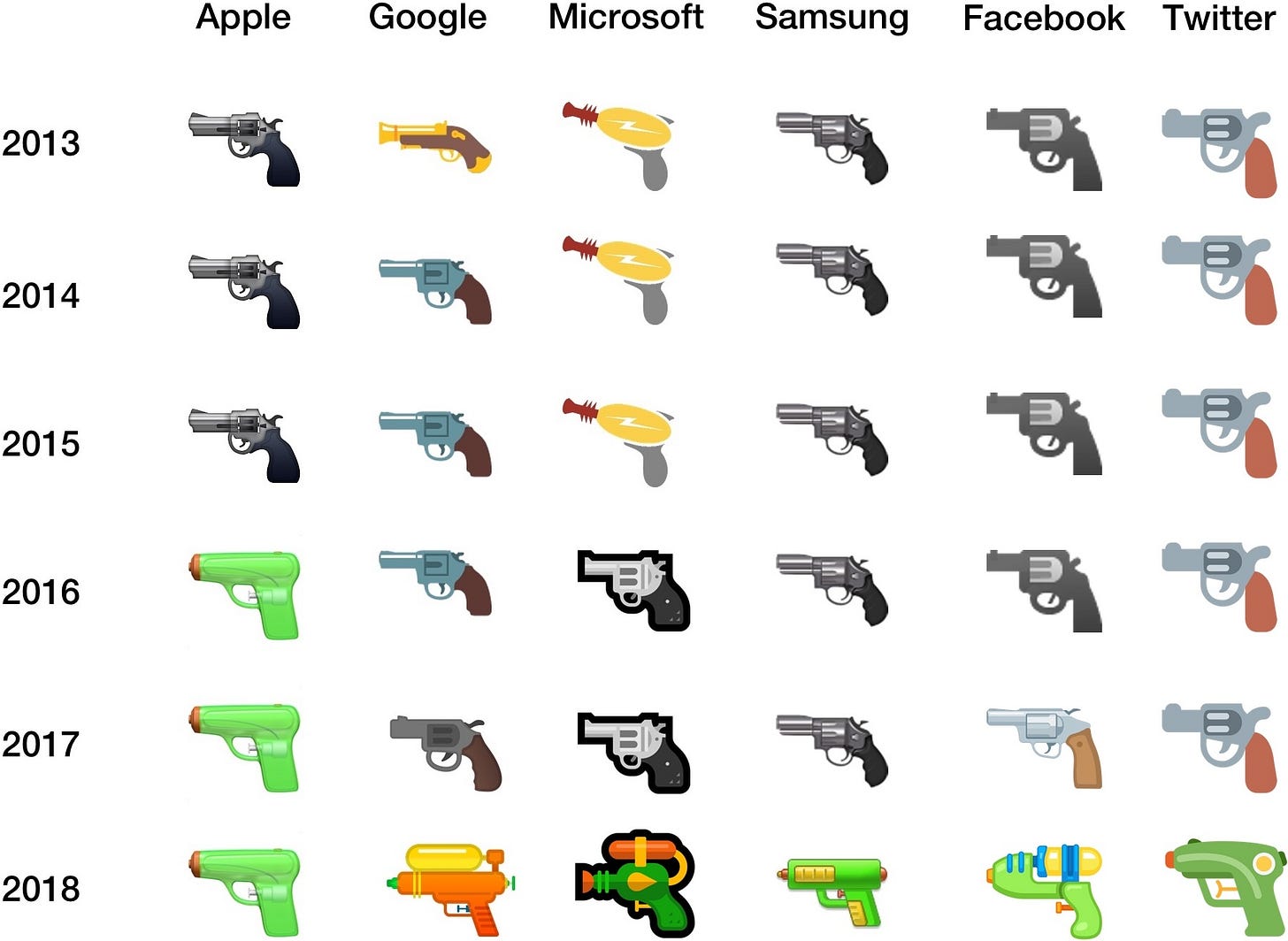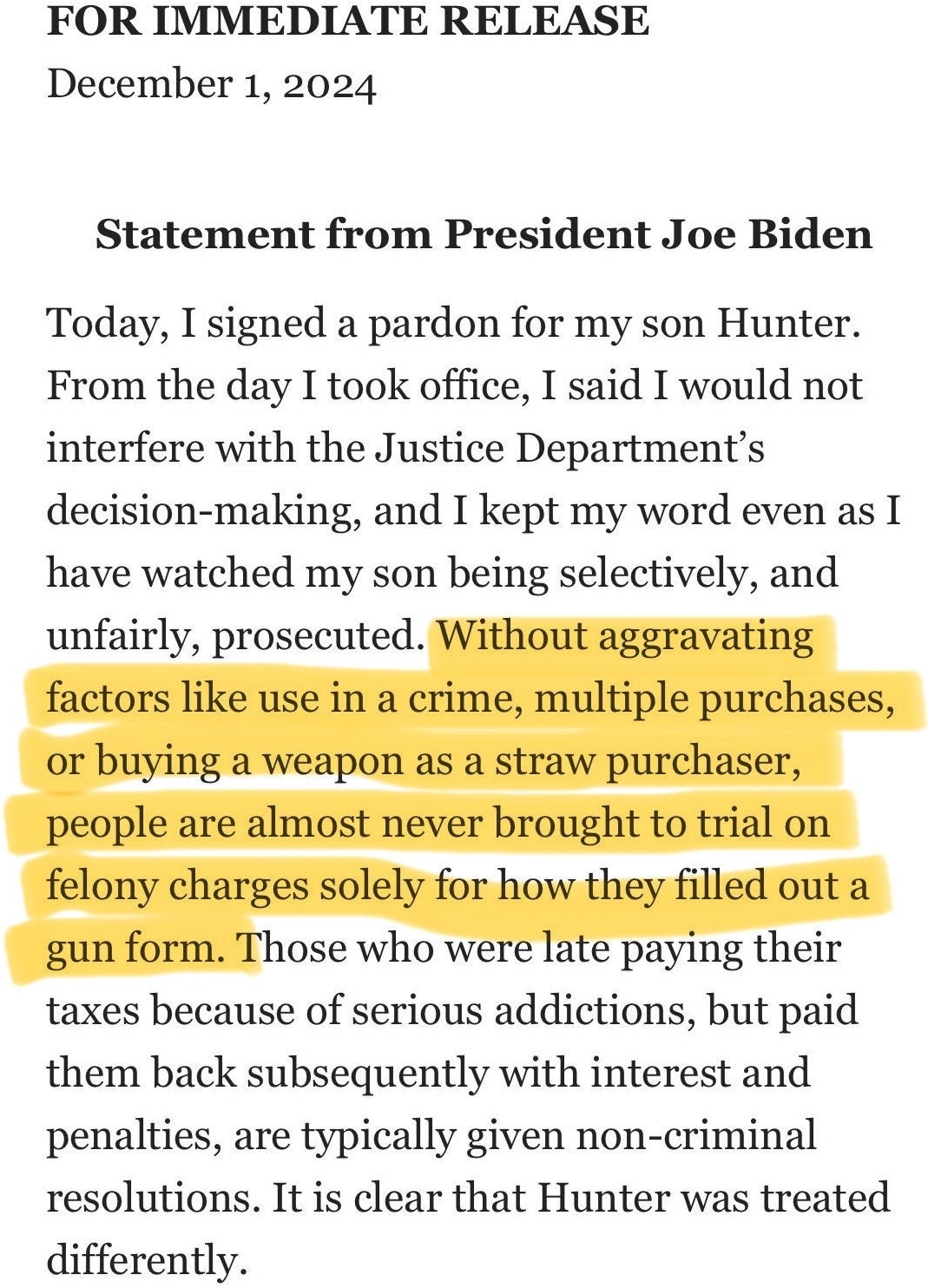OSD 302: The gun emoji, and other opportunities to reset what is normal
Won’t someone think of the children?
When Smith & Wesson got kicked off of Facebook last week and went on X to raise the alarm, Elon Musk hopped into the replies:
If you’re coming in with no context, “We restored the gun emoji” sounds like a weird thing to lead with. It would be like someone complaining about speech restrictions and Elon Musk coming in to say, “I believe in free speech. Look, I drew a picture of a computer.” On paper, that wouldn’t predict someone’s attitude about the underlying right.
In reality of course, it’s quite predictive. Why is that? As context, it’s useful to first understand what an emoji even is.
Unicode is a text encoding standard maintained by a nonprofit called the Unicode Consortium. It defines a list of graphemes (roughly speaking, letters and similar atomic units of writing) and other base-level elements (dashes, punctuation marks, etc.), and it gives each element in the list an id number. So U+0041 is the Latin uppercase letter A, U+0061 is the Latin lowercase letter a, U+00FC is ü (formally: Latin small letter u with diaeresis), U+1084D is the Imperial Aramaic letter nun, and so on for 155,063 characters across 168 languages and scripts.
What’s also included in those 155,063 characters is a bunch of symbols. For example, U+2191 is an upward arrow, U+25CC is a dotted circle, etc.
The key about all of this is that Unicode just encodes the symbols but not the way each symbol is drawn. So it encodes the concept of a Latin lowercase a by saying “Just call this thing U+0061.” Then when each platform is rendering text and comes across U+0061, it can decide how it wants to draw that concept. This was Unicode’s core innovation. In the before times, different platforms didn’t have a common way to refer to even the basic letters in the Latin alphabet, let alone the many thousands of other symbols that you might want to render in text. So text created on one platform would be gibberish on another platform.
This same idea makes cross-platform emojis possible, and Unicode encodes 3790 emojis as of version 16.0. The pistol emoji is U+1F52B. Remember what Unicode does. It encodes the concept of each symbol. So U+1F52B is the concept of a pistol. And it’s up to each platform to decide how to render that concept. Let’s see how they did it over the years:
Hmm. U+1F52B is a pistol. That is not the same thing as a water gun or a ray gun. Conflating them would be like someone saying, “Draw a picture of a grizzly bear” and then you draw a stuffed animal. Semantically just totally different.
Apple was the first to ignore the Unicode standard and depict “pistol” as a water pistol. Characteristically, they did not offer an explanation for why. The other platforms stuck to their guns, and Microsoft even went from a ray gun to a real gun. But then in 2018, all the platforms suddenly went to a water gun at the same time. How come?
Note the date on that tweet. It was just two months after the Parkland shooting, which was in retrospect the high water mark of the modern gun control movement. All of the platforms instantly caved, and ever since, all major platforms have depicted U+1F52B as a thing which it just simply is not. Until, that is, July 18, 2024, when @yacineMTB, an engineer at X, posted this:
Basically he just up and changed it back to a real gun.
This seems like a small thing. It’s not. To say that the cartoon depiction of a gun is unacceptable to display in-text on any modern tech platform is actually pretty radical. It means that the mere sight of a gun — a cartoon gun — is an inherent obscenity. And purely from a software engineering perspective, disregarding the Unicode standard to enforce that was unprecedented.
For six years, we lived in that world. Today, at least on X, we don’t. But imagine that Elon hadn’t bought X and we were stuck with water pistols for the long haul. Most people using a smartphone today remember when a pistol was a pistol. But after about two decades, the collective memory would have faded and the water pistol would seem utterly normal. The real pistol would seem aberrant, and as a result there’d be no hope of bringing it back. There’d be a new status quo, and going back to the old one would seem radical.
What’s normal and what’s stigmatized is really just a function of what you’re used to. With enough habituation, the normal can seem aberrant and the aberrant can seem normal. This cuts both ways for gun culture. There are actually several domains where guns are completely normalized. It’s not clear that that was inevitable. Rerun history 100 times, and you might only get today’s world 50 times:
Video games. Guns are everywhere. Games pride themselves on reproducing real-world guns accurately.
Film and TV. Ditto.
The American self-image. Whether people like guns or not, if they draw a caricature of Uncle Sam, he’s packing heat.
Social media. Every single gun account struggles with strikes and bans. But even so, it has never in history been easier to share info about guns and to spread gun culture.
Conversely, there are other areas where guns are fully stigmatized:
Children’s media. This isn’t a “you can’t even show Vietnam War movies in kindergarten anymore, what is the world coming to” rant. The very existence of firearms, even as lite comedy, is scrubbed from all children’s media. Elmer Fudd and Yosemite Sam are empty-handed now. It’s Christmas time, and gifting gun-related stuff to kids used to be utterly normal in media — think “a pair of Hopalong boots and a pistol that shoots is the wish of Barney and Ben” or the fact that in A Christmas Story, Ralphie says 28 separate times that he wants a Red Ryder BB gun for Christmas. And don’t even ask about Slowpoke Rodriguez. In 2024, kids cannot find out from their media that guns exist.
News coverage. If a gun appears on the news, it’s because it was used in a crime. There’s no such thing as positive gun ownership, let alone gun rights.
Social media. One thing Elon’s takeover of X has shown is that instead of putting massive effort into a content moderation system, you can simply … delete most of the rules. On Meta- and Google-run platforms, gun content lives under the sword of Damocles. Between the strictness of the rules and the high rate of false positives, the main effect of the system is to ensure that any gun-related account can be removed at any time.
That’s a description of where things sit today. But it can also serve as a roadmap. Our job now is to double down on the areas where guns are normalized, and to flip the discourse in the areas where they’re stigmatized.
This week’s links
AZAO, online store for not-destructive devices
85% sure this store is not an ATF honeypot, 100% sure they have cool stuff. Such as:
Thanks Palmer Luckey for flagging.
Interesting framing of Marc Andreessen talking about deplatforming on Joe Rogan
It’s the #metoo moment for government deplatforming.
Full and unconditional pardon for Hunter Biden
Good to see accidental bipartisan consensus for getting rid of the 4473.
About Open Source Defense
OSD Capital
We invest in civilian defense and tech that accelerates it.
OSD Podcast
In-depth interviews with outstanding founders and builders in the civilian defense industry.
Merch
Grab a t-shirt or a sticker and rep OSD.
Discord server
The OSD team is there along with lots of subscribers. Paid Substack subscribers can join the chat.







A few years ago I sent my kid to school in one of Q’s tshirts depicting a green army guy riding a skateboard. He was sent home in a different shirt and told not to wear that one again. His take: hey free shirt!
What I find funny, is that we’re in a very small rural school district, AND the principal’s husband is an 07/02. And the principal was very apologetic to me the next time I saw her.
It’s district policy sure, but I suspect it is a state mandate. Thanks Oregon.
Good point about the absence of firearms in cartoons, and the negative context that inevitably surrounds the appearance of firearms in news coverage. It's exciting to see the momentum building from something as simple as a proper "U+1F52B"